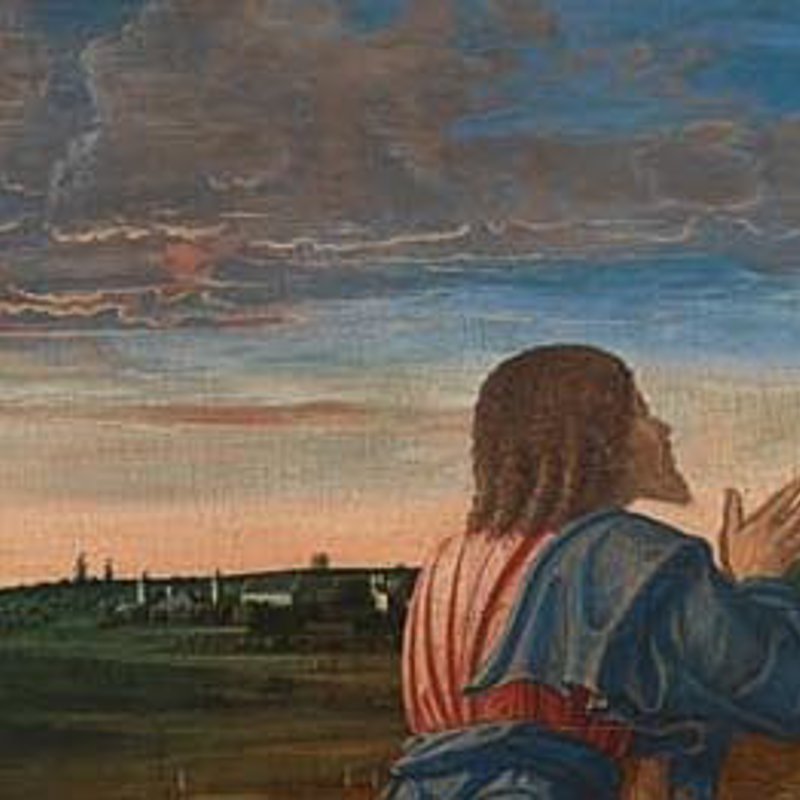Andrea Mantegna began his career in Padua, a vibrant university town on the Venetian mainland. A precocious talent, Mantegna made name for himself thanks to his powers of pictorial invention, mastery of storytelling and passion for the art of antiquity.
News of Mantegna’s genius quickly reached Venice. In 1453, the painter Jacopo Bellini – father of Gentile and Giovanni – arranged for his daughter Nicolosia to marry this rising star from Padua. After his marriage Mantegna developed a close artistic relationship with his brother-in-law Giovanni. This likely resulted in many comings and goings between Venice and Padua, where Mantegna remained.
Mantegna and Bellini shared subjects and motifs. This is evident in their versions of the Agony in the Garden, which exemplify both their characteristics and intrinsic differences. Mantegna’s Agony (about 1455-6) displays elaborate, antiquarian-inspired details. Bellini adapted Mantegna’s composition but focused on the atmospheric rendering of the landscape, using light to convey meaning.
Although many artists travelled to Venice to find work, Venetian artists like Gentile Bellini (1429-1507) were also in high demand abroad. Several years after he portrayed the Byzantine-Greek Cardinal Bessarion, Bellini travelled across the Mediterranean Sea to work for the powerful Ottoman Sultan Mehmet II.
Fascinated by European culture, Mehmet II had requested that the Venetian authorities send him a portraitist as part of the 1479 peace settlement between the Republic of Venice and the Ottoman Empire.
Gentile was one of the Republic’s most celebrated painters and, having recently completed a series of portraits of the doges of Venice, was chosen for the task. During his one-and-a-half year stay in Constantinople (present-day Istanbul) he acted as a cultural ambassador and worked on many commissions. Among the few works that survive from this period is his 'Portrait of Sultan Mehmet II'.
Palma Vecchio (1480–1528), whose original name was Jacopo Negretti. He was one of many artists from the 'Terraferma' – the Venetian mainland territories – who set up shop in Venice.
He was born in the village of Serina in northern Italy and probably trained in the nearby city of Bergamo - at the time part of the Venetian Republic. By 1510 he is documented in Venice, where he would work for the remainder of his career.
He developed a distinctive style, indebted to his contemporaries Titian and Giorgione. Towards the end of his life, he had established himself as one of the leading painters in the city.
While in Bergamo and Venice, Palma formed connections with textile makers, dyers and merchants. This informed his talent for painting luxurious fabrics, as is evident from his depiction of the sumptuous attire of the man in his painting.
Giovanni Girolamo Savoldo (about 1480–about 1548) shows the penitent Saint Jerome in the wilderness, contemplating the crucified Christ while preparing to beat his chest with a rock. The artist signed his name on the rock below the saint’s open book. The signature’s inclusion of ‘de Brisia’ indicates that he came from the northern Italian city of Brescia; then a territory of the Venetian Republic.
Although little is known of the first 40 years of his life, Savoldo seems to have travelled across Italy, working in Parma in 1506 and in Florence in 1508. He settled in Venice permanently around 1521, undoubtedly drawn by the city’s ample job opportunities and vibrant cultural life.
He is admired for his altarpieces and portraits, as well as for his skill at painting dramatic twilight scenes as exemplified in his 'Saint Jerome'.
El Greco has used theatrical gestures and intense colours to express the chaos and disruption of the Purification of the Temple – the moment that Christ drove out traders selling animals for sacrifice, furious that the temple was being used for commerce. Christ’s anger is shown through his body, arm raised ready to strike; he looks like a spring ready to uncoil.
A sculpture of Adam and Eve’s expulsion from the Garden of Eden, to the left of the archway, reinforces the sinfulness of the traders' actions. In contrast, Christ’s apostles stand in front of a relief sculpture showing the Old Testament figure Abraham, who was willing to sacrifice his own son on God’s command.
El Greco painted this subject at least four times, but this is one of the most dramatic versions. In the sixteenth century the episode was seen as a parallel to the cleansing of the Catholic Church through the Counter-Reformation.














